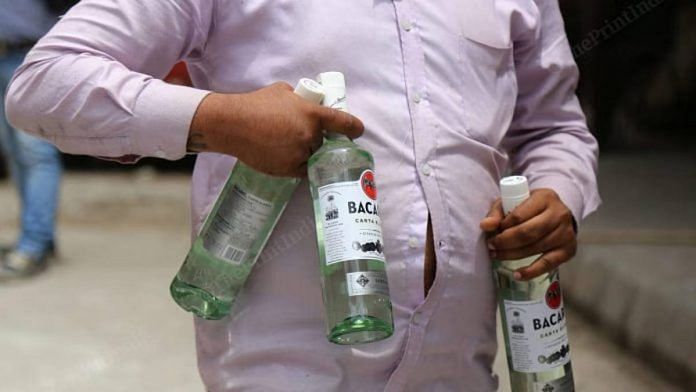New Delhi: While much of the world is cutting back on alcohol, India is doing the opposite. The country is projected to consume an additional 357 million litres between 2024 and 2029 — the biggest increase anywhere in the world, according to a new report by London-based market analytics firm Euromonitor International.
The report, titled ‘World Market for Alcoholic Drinks 2025’, notes that the glass is half-empty for the global booze market, with overall growth stagnating. The only high points are countries such as India, Brazil, Mexico, and South Africa.
“With discretionary incomes still under sustained and severe pressures across most key western markets – and beyond them – growth opportunities increasingly skew towards emerging markets like India,” Euromonitor said in a release.
In India, rising disposable incomes, a growing middle class, and evolving social norms around drinking are fuelling this upward trajectory — bucking a global turn toward mindful, moderated drinking habits in more mature markets.
The report captures the growing trend of ‘Zebra Striping’, which means alternating between alcoholic and non-alcoholic drinks in the same social setting.
However, much as India may love its tipple, it isn’t immune to the moderation movement.
Vansh Pahuja, founder of Sober, a homegrown non-alcoholic spirits brand, said he has seen a major shift in awareness and adoption over the past few years.
“Being at the forefront of this movement in India, I cannot emphasise how accurate the report is,” said Pahuja. “But alcohol isn’t going anywhere. People are just moderating the consumption, not completely dismissing it. Binge drinking is something people are avoiding now because the country is in its ‘health era’.”
As the ‘zebra stripe’ generation redefines what it means to enjoy a drink, the future of the global beverage industry will depend on its ability to cater to both sides of the glass, those who sip, and those who skip.
Also Read: India’s sober revolution—the young in the cities are cutting down on drinking
Sobriety over hedonism
Worldwide, only 17 per cent of consumers drink alcohol weekly, down from 23 per cent in 2020, according to the Euromonitor report, citing its ‘Voice of the Consumer: Health and Nutrition Survey 2025’. Among those who do drink, 53 per cent say they are actively trying to cut back, a significant jump from 44 per cent five years ago.
Even more striking is the generational divide. About 36 per cent of Gen Z adults of legal drinking age say they have never consumed alcohol.
Health is the main driver of this change. Nearly 87 per cent of respondents cited a desire to feel healthier and avoid long-term risks as their top reason for cutting down. Others pointed to saving money (30 per cent) and improving sleep (25 per cent).
But this doesn’t necessarily signal the end of social drinking. While some have a ‘sober’ drink for every alcoholic one, others are experimenting with new beverages.
In keeping with this abstemiousness, the report projects a volume growth of 24 per cent in the non-alcoholic category between 2025 and 2029, reflecting the rise of “sober curiosity.”
As reported earlier by ThePrint, India’s sober curious movement, too, is no longer a fringe trend. It’s evolving into a full-fledged market. Some of the players include Sober, Shark Tank-fame labels like Catwalk Botanics, and Sobriety Sips.
In 2024, global alcoholic beverage volumes grew by just 0.6 per cent, bringing the market’s total value to USD 1.7 trillion. By contrast, non-alcoholic alternatives saw double-digit growth: sober spirits up 17 per cent, ready-to-drink beverages up 14 per cent, low- and no-alcohol beer up 11 per cent, and non-alcoholic wine up 7 per cent.
(Edited by Asavari Singh)






